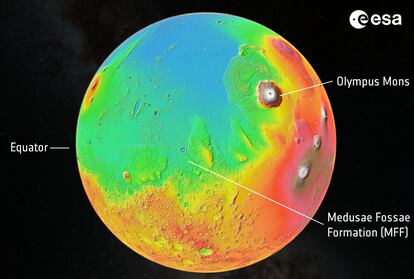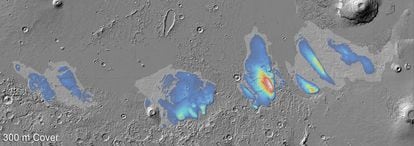It began when Giovanni Schiaparelli’s planets aligned. The Italian astronomer took benefit of the truth that, in 1877, the Earth and Mars had been on the identical aspect of the Solar and on the minimal distance between the 2 to attract a sequence of maps of the neighboring planet. In them, he offered a community of strains that he known as canali (channels) that unleashed wild hypothesis about their origin — maybe drilled by a Martian civilization — and what sort of liquid flowed via them. Nearly a century and a half later, proof to assist the existence of water on the Purple Planet is accumulating, providing vital alternatives for human exploration and the seek for life on Mars. A mission from the European House Company (ESA) has detected clear proof of the existence of huge blocks of ice within the flat, equatorial space of the planet, which can be essentially the most accessible for landings.
The Mars Specific probe, which the ESA despatched to the planet in 2003, detected massive underground deposits in 2007 within the windy area often called the Medusae Fossae Formation, however couldn’t decide whether or not they contained volcanic mud or different kinds of sediments. Now, the identical instrument and the identical scientists, due to new radar sweeps over the formation, current clear indications that big ice deposits are hidden beneath the floor. And they’re much bigger than what was initially measured: probably between 219,000 and 396,000 cubic kilometers of frozen water. Have been it to soften, it will flood your complete planet below a layer of about two meters of water. Its quantity is bigger than all of the contemporary water on Earth contained in rivers and lakes, and could be sufficient to fill the Purple Sea.
“It could possibly be a really beneficial useful resource for future human exploration,” says Thomas Watters, a scientist on the Smithsonian Establishment. Water is a really treasured commodity for future planetary exploration, not solely to alleviate the thirst of astronauts, but additionally as a supply of gas. “It has the benefit of being positioned on the equator of Mars and within the northern lowlands, ideally suited as touchdown websites,” the principle creator of the research, carried out with the Italian House Company’s MARSIS gear, provides in response to EL PAÍS. “Medusae Fossae’s ice-rich deposits may assist clarify the place the massive quantity of water that helped reshape the floor of Mars ended up,” Watters says, referring to channels and different geological formations.

In 2018, Mars Specific positioned a big lake of liquid water below the Martian polar ice. However these newly found huge ice deposits, the biggest exterior the poles, are in a way more accessible level on the planet. The Medusae Fossae are on the graceful plains of a area north of the equator, removed from the damaging mountainous terrain to the south the place there are various craters that might jeopardize a touchdown. As Alberto González Fairén, a researcher on the Heart for Astrobiology in Madrid and at Cornell College in New York, factors out, one in all these deposits is simply 500 kilometers (310 miles) from the Gale Crater, “the place we’ve had the Curiosity rover exploring the terrain for greater than 11 years.”
“It’s a very attention-grabbing discovery,” provides Fairén. “It confirms what we’ve discovered in current many years: these huge ice deposits, if confirmed to be so, affirm that Mars was as soon as a planet very wealthy in liquid water. If the info are confirmed, it will be further proof that Mars was a world considerably extra just like Earth up to now.” Watters’ crew states in its research, revealed in Geophysical Analysis Letters, that the indicators returned by the MARSIS radar about these deposits can solely be defined by the presence of ice, and that they’re similar to these captured within the discovery of Martian polar ice. “Very soiled ice, however water ice. Whether it is confirmed,” insists Fairén, who notes that the MARSIS crew is finishing up complementary investigations to corroborate the findings.
Life and astronauts
“It might be of remarkable significance, since it will be ice that could possibly be accessible sooner or later, within the area of the planet the place it’s simpler to land, and the place there are extra hours of sunshine and the winters are much less freezing. It might be an distinctive location to start exploration with astronauts,” notes Fairén. The Artemis program, promoted by NASA and supported by 30 international locations, goals to take a manned mission to Mars properly into the 2030s, however step one of the challenge is to set foot on the moon once more this decade, plans which were delayed.

Life on Mars
This ice could present clues to the climatic historical past of Mars, the way it grew to become so arid, and what grew to become of the seas that when lined its floor. However water, above all, is a key component for all times as we all know it. The doable existence of life on Mars up to now, when it resembled Earth, but additionally right this moment. “When there may be water, even water ice, life or proof of previous life is feasible. Sadly, if we’re proper in regards to the thickness of the dry layer, it is going to be a problem to acquire a pattern of the ice core,” Watters acknowledges. For Fairén, “curiosity focuses on the potential for present life.” With water ice at such low latitudes, it’s doable that soften pockets liveable by microorganisms could happen, no less than quickly. “After all, for Martian life to exist right this moment, the circumstances for biogenesis must have been met very early within the geological historical past of Mars, and that is a gigantic query that we aren’t but able to resolve,” notes Fairén.
Watters is dedicated to sending new missions to the world to have the ability to clear up the mysteries of the ice, in “a superb website for future explorations with rovers.” “Devices like ground-penetrating radar could be a great begin, and a drill could be essentially the most direct option to pattern the deposits,” he proposes, “however it will be a big problem for a robotic mission.” Fairén agrees, provided that the ice is below layers of between 300 and 600 meters of land: “The truth is that entry to all these deposits is, right this moment, unfeasible. The know-how to put in drills on Mars able to reaching tons of of meters deep shouldn’t be but accessible.”
Nonetheless, the researcher warns that this discovery poses one other problem for astrobiology: “We should take excessive precautions to not introduce on Mars, through our exploration automobiles, terrestrial life that might accommodate itself in these interfaces. If we contaminate Mars, it will be very troublesome to seek out a solution to the big query of whether or not there ever was Martian life.” The colonizing spirit of some house plans, with extra haste than thought, may endlessly break the dream of understanding whether or not one thing dwelling inhabited Schiaparelli’s canali.
Join our weekly publication to get extra English-language information protection from EL PAÍS USA Version

